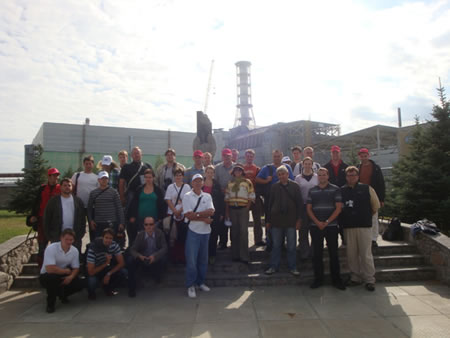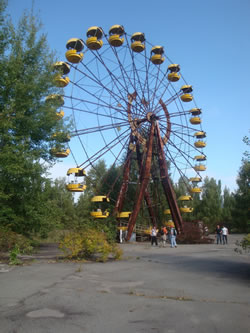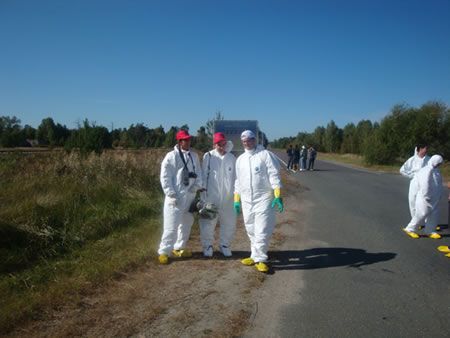
SNUS Scientific Expedition to Chernobyl NPP
The Slovak Nuclear Society (SNUS) recently organised a scientific expedition to the Chernobyl Nuclear Power Plant and its surroundings. The expedition took place from 11 – 16 September. The participants included SNUS members from universities and representatives from the utilities Slovenské Elektrárne Inc. (the national NPP operator in Slovakia) and JAVYS Inc. (a company specialising in NPP decommissioning). The main goal of the expedition was to monitor conditions at the NPP and in its surrounding area 25 years after the accident that took place at the plant’s Unit 4.

The programme of the expedition focused on collecting information related to the preparation of step-by-step decommissioning and cleaning, the visit of the information centre and the sarcophagus that covers the damaged unit, the visit of the control room of the shut-down Unit 1, the measurement of radiation dosage levels at the plant and in its vicinity and the collecting of samples from the local environment for subsequent analysis and measurement in the plant’s radiochemical laboratories. Of course, a visit of the ghost city Pripyat was also a must. Once, Pripyat used to be home to the plant’s workers and their families.
Participants travelled by bus to Slavutich, where the plant employees (about 3,000 people) live at present. Slavutich, with a population of 25,000 was built in in a record-breaking period of 18 months (construction began in January 1987) and 8 republics of the former Soviet Union participated in its construction. Today, employees are transported from Slavutich to the plant by train, which commutes four times a day (about half of the railway line cuts through Belarus).
On the first day of the expedition we had a look at newly-built equipment used for processing solid and liquid radioactive waste that were manufactured thanks to a substantial contribution from the company NUCEM. The equipment is being used for training personnel in the starting-up of testing, and standard operation.
In the afternoon we moved to the “Red Forest” where measurements were carried out and samples were collected for radiochemical analysis. The Red Forest is the area that was most affected by the accident, which is clearly evident even today. Works associated with the decontamination of the area are still going on. Nonetheless, flora and fauna does not show any significant anomalies. Of course, this area is uninhabited.
The next day, we visited the Information Centre located close to the Unit 4 sarcophagus and familiarised ourselves with the current status of the sarcophagus, which was erected within 206 days. During its construction, more than 90 thousand people worked relentlessly day and night. The technology used during its construction is located in a vast area that remains inaccessible. Due to the worsening state of the sarcophagus (mainly due to the weather conditions) it was decided to build a new shelter over the existing structure. The contract for the work was won by the consortium NOVARKA, led by two French companies. Financing of the project was supported by 2 million€, from Slovakia Altogether, 800 million€ were collected from 28 countries around the world and from the European Union.

We also had an opportunity to visit Pripyat (about 4 km from the damaged Unit 4), where about 49,500 people lived at the time of the accident. The city was evacuated in the afternoon of April 27, 1986 using about 1200 buses with the promise that people would return within three days, which, of course, never happened. The city has now been abandoned to nature and you can see the ravages of nature after 25 years. Members of the expedition took a lot of photographs and videos. By the way, funds set aside to support “nuclear tourism” simple disappeared into thin air – nobody knows where.

In the afternoon, we were able to visit see the control room of Unit 1 and received information about the specifications of this type of nuclear power technology and about the operation of the intact units, which continued up to 99 and 2000 respectively. After that date all units of the plant were shut-down for good. Today, personnel organised in shifts work there - 20 employees per shift.
On the last day, we had a look at the Chernobyl museum, in Slavutich, and visited a radiochemical laboratory located there. Some participants analysed the samples collected in the Red Forest.
Two weeks after the expedition the government of Ukraine cancelled all further trips to Chernobyl until further notice. A correct decision…
Experiences gained from this expedition and a summary were published in the 2/2012 issue of SNUS Bulletin.
Jozef Markuš
Vice Chairman of SNUS and a participant in the expedition
|

